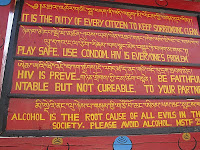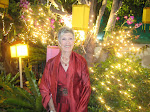

POKKARA and the HimalayasArriving in Pokkara from Kathmandu was like a taste of heaven. Left the city in heavy rain and came to this peaceful place situated on lakes with the snow capped Himalayas all around. On the long bus ride the general air leaving Kathmandu was one of shabbyness. Plastic sheets constituted the awnings, the walls and the curtains of most of the shacks, shops and houses. The trees and bushes were white and dusty. Gradually the landscape became greener. Ovens in front of houses and restaurants were fashioned from red clay - big practical platforms with ledges for pots and pans - wood was burning in a large opening below while openings on top allowed the heat to do the cooking. Houses were built of the usual concrete but gradually many were made of local stone and those of brick were plastered and colour began to appear mainly terracotta and blue. The disturbing thing in Nepal is the mess along each road and in front of every living area. The ground is not paved and is a mess of scrub, dirt, rocks, sand, stones large and small, rusting pipes, big potholes, tubes, bricks and logs plus cows, buffalo, goats, rubble, dogs, squatting people, children, women washing clothes, men washing themselves and general dirt, plastic, trash, hens and motor bikes and jeeps.
It is very interesting to see how the bus boys work. They hang out of the side of the bus and shout out the destination to everyone who is standing or squatting along the route. Regardless of how full the bus is already, more are encouraged to board until it is absolutely jam packed. Stools are placed in the aisles, people stand uncomplainingly almost on top of each other, they hang off the sides and back while the bus jolts and bumps along. One bang on the bus side means stop to the driver for yet more customers or to allow some off. Two bangs mean go. The boy is meanwhile taking money and often has to run to catch up with the bus again.
Along the roads haystacks looked very high until I realised that they were raised on platforms and built around a pole. I suppose for faster drying.
The rain stopped as we arrived, we being a nice Chinese girl named Jessie who was on the same bus. We found a nice guest house where it is much warmer than in Kathmandu and there are light filled rooms and even hot water sometimes. I had a great warm shower immediately. Buildings in the city are so close together that the view from the window is often a brick wall so that makes places very dark especially without electricity.
The weather was gorgeous after the rain, blue skies and sun. We had a bit of a climb yesterday to the Peace Pagoda overlooking the town. It was steep but the views were great and we took a boat across the lake to get there. This was a place that was discovered by all the hippies back in the good old days and they hung out here for months “finding themselves” It is touristy in the way that everyone here is looking out for trekking the Himalayas, learning how to be instructors of Paragliding, gliding with vultures etc. The Annapurna Circuit takes 20 days of trekking but there are also shorter options. There are lots of bars, restaurants, guest houses and cafes and the competition keeps prices down a bit. There’s not much traffic so it is lovely and quiet. The Newari people are the majority and they are really kind and have beautiful smiles.
Still it is sad to see that foreigners are only viewed a bit like an ATM machine. Even little children have a go at asking for a pen, rupees or sweets.
Yesterda

y morning was a real highlight for me. Decided to take advantage of the wonderful views and go Paragliding. It was terrific with a really competent pilot just floating along in the air over the lake with the mountain peaks glistening in the sun and the lake below. Up there among the birds. I loved it. Hope to upload a few pictures taken in the air.
Today I rented a bike and explored the area for a while although it rained quite a lot this morning. Today in Kathmandu is the start of the biggest Hindu festival of the year named Mahashivaratri and over 600,000 Pilgrims are expected there. There will be Sadhus selling Marijuana joints for around a euro a stick as an offering to the Lord Shiva abnd Naga Babas who are nude medicants who give out blessings. I'm sure you've all seen pictures of them with faces whitened and body paint. It will cost the city 1.3 million rupees for their food and shelter. Typically woman line up at the temple and attend in the day and the men go at night and get stoned. Here in Pokkara it is a much smaller affair. Right now close to where I am writing this there is a big bonfire and women are dressed in their lovliest saris and everyone is thrusting long

sugar canes in to the fire and causing loud bangs and bits of cane flying all around the place. Today many women were walking around with their prayer beads and some of them were dancing around quite alone. Hindi's are very devout and say God bless you many times. As a Nepali said to me today "Hindus have more Gods and Godesses than the population of Nepal.
I will start back towards Kathmandu tomorrow hopefully spending a night in a tiny, unspoiled village on the way if I can get transport to it. Of course there will also be the hope that I can leave there on Sunday and return to Kathmandu as it is up a mountain and there is no direct transportation. Thats travel and the fun of it.
http://picasaweb.google.com/a.roantree/Pokkara#

 the roads the same as men. There are often delays for rock slides and sometimes the guide has to move a large rock out of the way. There is just one road that runs across this country so when we return we will go the same way again. Have to say that is just fine with me. The roads are scary but the drivers are excellent and the brakes are good.Mindup had stocked up with a tiffin like
the roads the same as men. There are often delays for rock slides and sometimes the guide has to move a large rock out of the way. There is just one road that runs across this country so when we return we will go the same way again. Have to say that is just fine with me. The roads are scary but the drivers are excellent and the brakes are good.Mindup had stocked up with a tiffin like container that fits in to a thermos so we had a picnic on our way with the usual red rice, chilies and soft cheese, meat, veg., dal and apple juice. It seems that we will drop back all the containers on our return trip. Flasks full of very hot water are always carried so that one can have a hot drink or tea on each trip
container that fits in to a thermos so we had a picnic on our way with the usual red rice, chilies and soft cheese, meat, veg., dal and apple juice. It seems that we will drop back all the containers on our return trip. Flasks full of very hot water are always carried so that one can have a hot drink or tea on each trip


































